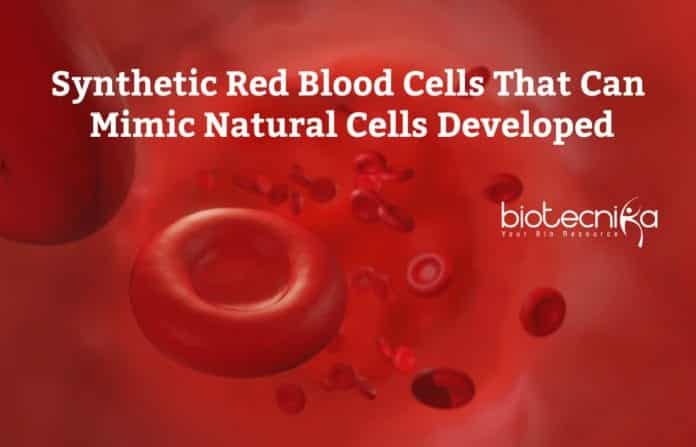New Synthetic RBCs Developed That Can Mimic Natural Cells Effectively
Researchers have been trying to develop synthetic red blood cells that mimic the natural ones and their favorable properties, such as long circulation times, oxygen transport, and flexibility. However, most of the synthetic or artificial red blood cells developed so far do not have all the key features of the natural versions, they have had one or a few only features. According to the ACS Nano journal, researchers have now developed synthetic red blood cells that can mimic the natural ones having all of the cells’ natural abilities, and also few new abilities additionally.
Red blood cells (RBCs) delivers oxygen to the body’s tissues by taking up oxygen from the lungs. Millions of hemoglobin (an iron-containing protein that binds oxygen) are present in these disk-shaped cells. RBCs can squeeze through tiny capillaries and then bounce back to their former shape as they are highly flexible. They are able to circulate through blood vessels for a long time without being gobbled up by immune cells as they contain proteins on their surface.
Researchers C. Jeffrey Brinker, Wei Zhu, and colleagues wanted to develop artificial RBCs having properties alike the natural RBCs
, which can also be capable of performing new tasks such as toxin detection, magnetic targeting, and therapeutic drug delivery.First, the researchers coated the donated human RBCs with a thin layer of silica to make the synthetic cells. Over the silica-RBCs, they layered polymers that were positively and negatively charged. Then flexible replicas were produced as they etched away from the silica. Finally, natural RBC membranes were coated on the surface of the replicas.
The artificial cells could squeeze through model capillaries without losing their shape as these cells were similar in surface proteins, charge, shape, and size to natural cells. There was no toxicity observed with the synthetic RBCs in mice, which lasted for more than 48 hours.
To demonstrate that the artificial cells could carry cargoes, the researchers loaded them with either an anticancer drug, hemoglobin, a toxin sensor, or magnetic nanoparticles. The new RBCs could also act as decoys for a bacterial toxin, showed the team. The researchers say that the potential of the artificial cells in medical applications, such as cancer therapy and toxin biosensing will be explored in future studies.
The funding for the study was provided from the Laboratory Directed Research & Development Program at Sandia National Laboratories, the Air Force Office of Scientific Research, the National Natural Science Foundation of China, and the National Institutes of Health, and the Department of Energy Office of Science.
Source
New Synthetic RBCs Developed






























